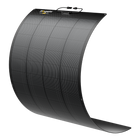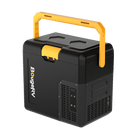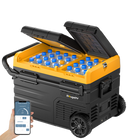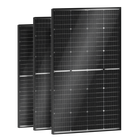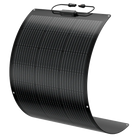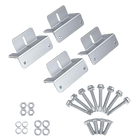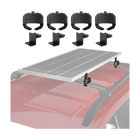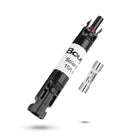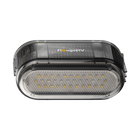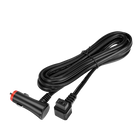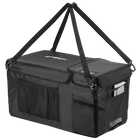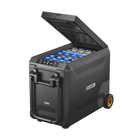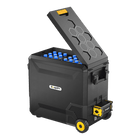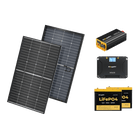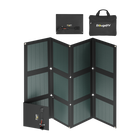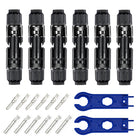How to Make a 30 Amp Generator Extension Cord?

How to make a 30 amp generator extension cord? The generator extension cord is heavy-duty and you can use it in your recreational vehicle and other outdoor activities. These extension cords are available online and in many stores. But if you’re looking to do it yourself, you can!
But as how important that is to know what kind of an RV deep cycle battery to use, you should know the type of extension cord to buy and check for its quality, thickness, and length. Once done, you can gather your materials, as listed in the following, and then follow the steps to make an extension cord.
Things you’ll need
- Two receptacles
- Male plug
- Extension cord (size number 10)
- 4x4 square box with cover
- Strain relief cord connector or cgb
- Gloves
- Screwdriver
- Pliers
- Knife
- Scissors
- Electrical tape
Step 1: Knock a Hole on the Square Box
Use the pliers to knock a hole in the square box.

Step 2: Strip the Cord
Use the pliers to strip the cord. From the end, measure about 2.5 inches. Make sure to do it carefully to avoid cutting the wires.

Step 3: Cut some of the Wires
When you remove the stripped cord and cut some of the wire, you will no longer use it to make the extension cord. Leave the hot, neutral, and ground wires. Use the scissors for this step.
Step 4: Put the CGB on the Square Box's Hole
Once you put the CGB on the hole, lock it using the Channel-lock pliers.

Step 5: Insert the Wires on the CGB
Make sure the wires are inside the box, then lock the CGB.

Step 6: Strip the Wire
When you strip the wire, you can use the pliers with strippers. Make sure not to strip it too much.

Step 7: Make 2 Grounds
Cut the wire to make the grounds, one for each receptacle and the ground from the generator.
Attach the other wire to the box. You may use wire nuts while doing this step. Tighten the wire nut using your fingers or the strippers. Then pull the wires to make sure they are in good contact.

Step 8: Connect the Wires to the Receptacles
Twist the wires before you connect them, then tighten them using the screwdriver. Make sure the connections are in the right spot. You may secure the wires using electrical tape.

Step 9: Attach the Receptacles to the Cover of the Square Box
Before you attach the receptacles, remove the screws first. Then, place the cover on the square box and lock it using the screws you removed previously.

Step 10: Connect the Other End of the Wire to the Male Plug
Strip a bit of the wire before connecting them. Remove the screws of the male plug and check the connections before you bring them back.

Tips to Remember When Choosing and Using an Extension Cord
Extension cords are essential both indoors and outdoors. However, they are available in different types, be sure to know their differences. By following the tips below, you can choose the right extension cord and use it properly.
- Check for cord length, wire thickness, and amp rating.
- Always make sure you have good connections when using an extension cord.
- Avoid using an indoor extension cord outside.
- Use an extension cord only when necessary.
- Do not use an extension cord with a lower wattage/amperage than what you’re trying to use it for.
- Look for any damage to the cord itself. If you notice a cut in it, reach for the wires inside and do not use it. Additionally, if it is superficial, you can use electrical tape to repair the cord.
- Check and make sure all the connections are tight and secure before plugging them into a power source.
- Never pull the extension cord itself when you disconnect it. Pull the plug to separate.
- Some cords have handles to make it easier to unplug.
- Try to keep any connections in the cord off the ground. Avoid exposing them to moisture or standing water.
- Try to limit the number of adaptors you use.
- If the cord or the adaptor ever feels hot, discontinue using it. Some adaptors can melt and short circuit when too hot.
- Unroll the extension cords fully to prevent coils during use.
How to Determine the Capacity of an Extension Cord
Before you purchase an extension cord, check its wire gauge rating. Keep in mind that the lower the AWG (American Wire Gauge Rating) number, the thicker the wire, and the higher the rated capacity, and vice versa. The higher the AWG number, the wire thickness is less, and the rated capacity is lower.
For RV applications, your ideal option is the lower AWG number with a higher rated capacity. When you look for an extension cord, you will notice various labels. If you have no idea how to read it, here's an example.
When you see 14/3, the number 14 represents the gauge or thickness of the wire, and 3 is the number of wires in the cord.
Facts about Extension Cords
When it comes to extension cords, you might know what it is and its uses. But you probably don't know yet about the following facts.
- Extension cords are only for temporary use.
- Regular household extension cords are for either indoor or outdoor use.
- Outdoor extension cords have a thick covering of additional insulation.
- For your RV, use an extension cord with a ground wire to help reduce the possibility of electrical shock.
- Extension cords are convenient when the RV's power cord is not long enough to reach the power pedestal.
- The gauge and length of the wire both affect the cord's amperage rating. For example, a ten-gauge wire that is 25 feet long has a rating of 30 amps.
How to make a 30 amp generator extension cord? For sure, you can create one for yourself now. Be sure to follow the above steps and tips for your guidance. Until our next tutorial!
Stay tuned for our latest tutorials. Do you think your friends need this information too? Share it on social media today!
A power cord is one of those hardware specifications that can directly affect the output voltage you receive. I'm sure you already know how important a suitable generator cord is.
However, we all know that not everyone is a natural handyman. You may not be successful in trying to follow through with making your own cord. If you need to use it again immediately, then you may now choose to buy one that is more suitable.
Here is a step-by-step guide to choosing and using a generator extension cord:
Step #1. Select the Right Amps for your Cord
The first step to choosing a generator extension cord is to look at the amps through which generator extension codes are actually measured.
There’s a simple thumb rule to follow - the larger the amps, the more electricity the cord can handle.
Make sure you go for a cord that has enough amperes to handle your electricity flow. On average, a 50-amp cord works well for basic domestic and commercial needs.
Step #2. Select the right generator Cord Shape
As you finalize the right amps for your cord, you have to choose the right generator cord shape:
We have 3-prong, 4-prong, twist-lock, and straight-blade as the type for direct cords. You can choose any of them depending on the shape your generator has got.
Usually, for the domestic use generators, we have 3-prong and 4-prong cord shapes as these can handle up to 30 amps. While for business and commercial needs, we have Twist-Lock and Straight-Blade as these can handle about 50 amperes easily.
Step #3. Plugging In
Before you connect your appliances, double-check that the generator cord is undamaged and is safe to use. A damaged cord can result in electric shock.
As you proceed with the above measures, you simply have to plug in the cord, and voila, it is all set to transfer power.





